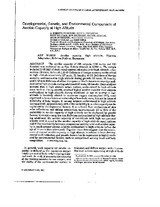Mostrar el registro sencillo del ítem
Developmental, genetic, and environmental components of aerobic capacity at high altitude
| dc.contributor.author | Frisancho, A Roberto | |
| dc.contributor.author | Frisancho, Hedy G | |
| dc.contributor.author | Milotich, Mark | |
| dc.contributor.author | Brutsaert, Tom | |
| dc.contributor.author | Albalak, Rachel | |
| dc.contributor.author | Spielvogel, Hilde | |
| dc.contributor.author | Villena, Mercedes | |
| dc.contributor.author | Vargas, Enrique | |
| dc.contributor.author | Soria, Rudy | |
| dc.date.accessioned | 2019-08-27T18:48:06Z | |
| dc.date.available | 2019-08-27T18:48:06Z | |
| dc.date.issued | 1995 | |
| dc.identifier.uri | http://repositorio.umsa.bo/xmlui/handle/123456789/22588 | |
| dc.description.abstract | Abstract. The aerobic capacity of 268 subjects (158 males and 110 females) was evaluated in La Paz, Bolivia situated at 3,750 m. The sample included 1) 39 high altitude rural natives (all male); 2) 67 high altitude urban natives (32 male, 35 female); 3) 69 Bolivians of foreign ancestry acclimatized to high altitude since birth (37 male, 32 female); 4) 50 Bolivians of foreign ancestry acclimatized to high altitude during growth (25 male, 25 female); and 5) 42 non-Bolivians of either European or North American ancestry acclimatized to high altitude during adulthood (25 male, 18 female). Data analyses indicate that 1) high altitude urban natives, acclimatized to high altitude since birth or during growth, attained higher aerobic capacity than subjects acclimatized to high altitude during adulthood; 2) age at arrival to high altitude is inversely related to maximum oxygen consumption (VO2 max) expressed in terms L/min or ml/min/kg of lean body mass, but not in terms of ml/min/kg of body weight; 3) among subjects acclimatized to high altitude during growth, approximately 25% of the variability in aerobic capacity can be explained by developmental factors; 4) as inferred from evaluations of skin color reflectance and sibling similarities, approximately 20 to 25% of the variability in aerobic capacity at high altitude can be explained by genetic factors; 5) except among the non-Bolivians acclimatized to high altitude during adulthood, the aerobic capacity of individuals with high occupational activity level is equal to the aerobic capacity of high altitude rural natives; and 6) the relationship between occupational activity level and aerobic capacity is much greater among subjects acclimatized to high altitude before the age of 10 years than afterwards. Together these data suggest that the attainment of normal aerobic capacity at high altitude is related to both developmental acclimatization and genetic factors but its expression is highly mediated by environmental factors, such as occupational activity level and body composition. | es_ES |
| dc.language.iso | en | es_ES |
| dc.publisher | American Journal of Physical Anthropology | es_ES |
| dc.subject | CAPACIDAD AERÓBICA | es_ES |
| dc.subject | ALTURA | es_ES |
| dc.subject | HIPOXIA | es_ES |
| dc.subject | ADAPTACIÓN | es_ES |
| dc.subject | NATIVOS BOLIVIANOS | es_ES |
| dc.subject | EUROPEOS | es_ES |
| dc.title | Developmental, genetic, and environmental components of aerobic capacity at high altitude | es_ES |
| dc.type | Article | es_ES |

